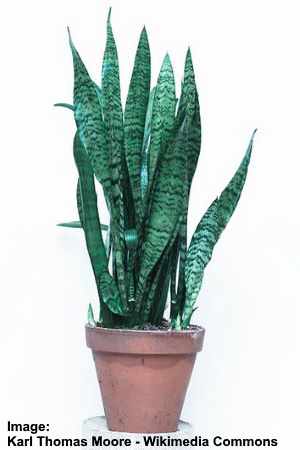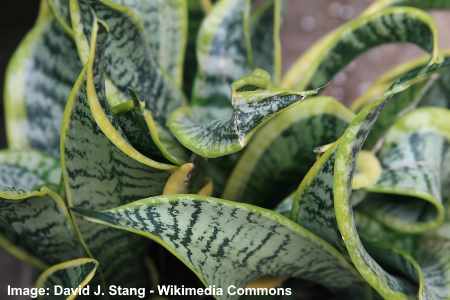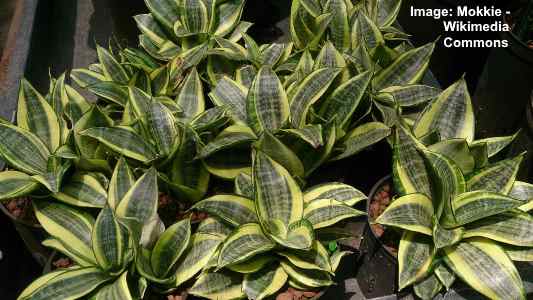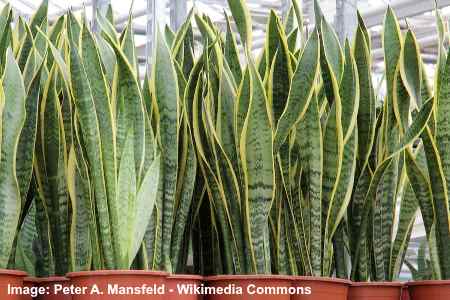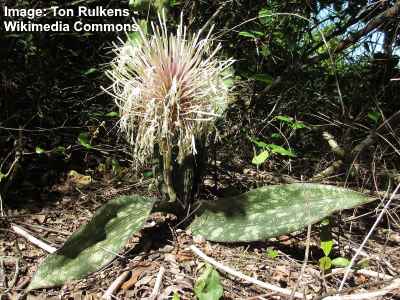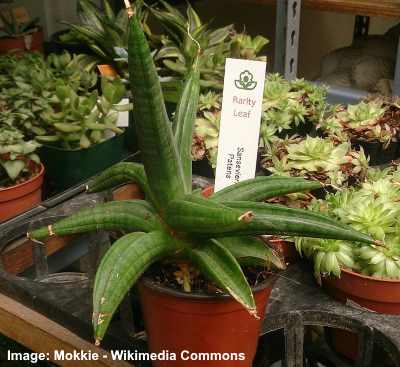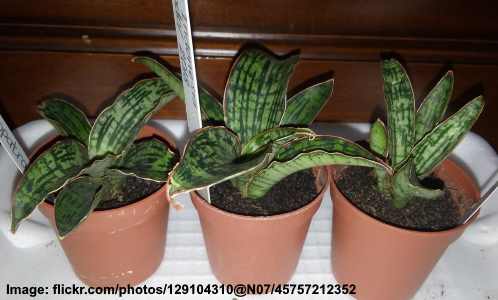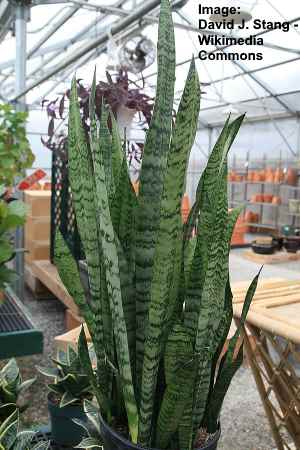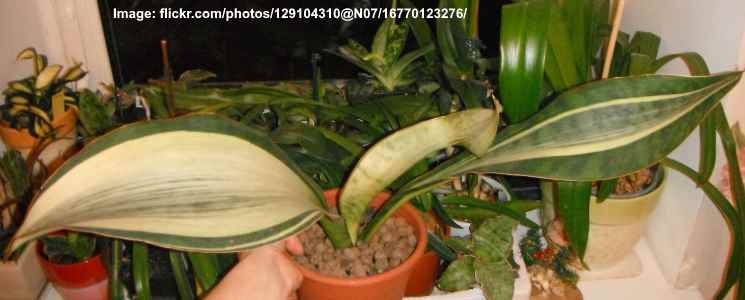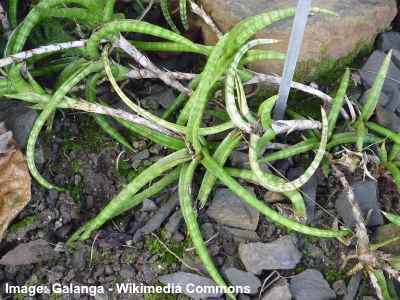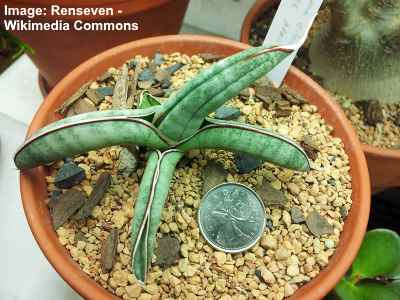Types of Snake Plants (Sansevieria Varieties) With Care and Growing Tips
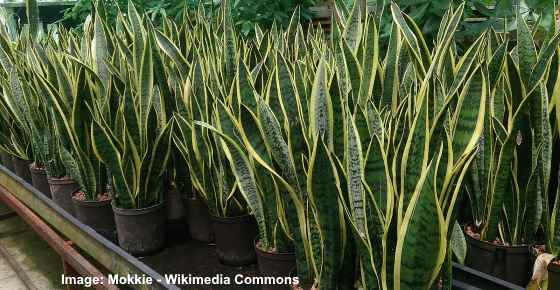
All varieties of the snake plant (genus sansevieria) are succulents that grow well indoors as houseplants. Also known as viper’s bowstring hemp, or mother in law’s tongue, sansevieria varieties are excellent houseplants that suit your home decor.
Some snake plant varieties have a long sword-shaped flat green leaves. Other tropical sansevieria varieties such as sansevieria cylindrica (African spear plant), and starfish sansevieria have cylindrical round leaves with pointed ends. There are even snake plant varieties such as Sansevieria Trifasciata ‘Black Gold’ that can be used as air filtering house plants.
How to Care For Snake Plants (Sansevieria Varieties)
To care for sansevieria varieties (snake plants) grow the plants in well-draining potting soil and water them when the soil is dry. In winter, only water your snake plants (sansevieria) occasionally. Snake plants grow well indoors at normal room temperature. Fertilize sansevierias once a month in spring and summer. To help the snake plant grow well indoors use a pot with a drainage hole in the bottom.
About Sansevierias
One of the reasons to grow sansevierias indoors is that they grow well in poor conditions. These succulents requires little maintenance and can provide attractive green and yellow colors to your home décor.
There are about 70 species of Sansevieria. Theses are flowering plants in the genus Sansevieria and in the plant family Asparagaceae. Sansevieria varieties are colloquially known as ‘snake plants’ because of their long leaves and tapered ends.
Depending on the variety, other types of sansevieria plants have other common names. For example, the Sansevieria trifasciata is commonly named ‘mother-in-law’s tongue.’ Its name comes from the fact that the plant leaves are long and sharp. This sansevieria variety is also called ‘viper’s bowstring hemp’ because its fibers are strong enough to make bowstrings.
Snake Plants (Sansevieria) Benefits
One of the main benefits of growing a snake plant (sansevieria) indoors is its ability to filter certain toxins from the air. The advantage of growing Sansevieria laurentii (Mother in Law’s Tongue) is that it reduces the levels of the toxins Trichloroethylene (TCE), Benzene, and Formaldehyde. This benefit was reported in a study conducted by NASA.
In this article, you will learn about many varieties of plants in the Sansevieria genus. The descriptions and pictures of these sansevierias will help to identify the individual species and find out about their common names. At the end of the article you will learn how to care for snake plants.
Types of Snake Plants (Sansevieria Varieties) – With Pictures and Common Name
One of the most popular varieties of sansevieria are plants in the species Sansevieria trifasciata. It is also known under the synonym Dracaena trifasciata.
Here are some of the common types of sansevieria (snake plants):
Sansevieria Trifasciata ‘Black Gold’ (Viper’s Bowstring Hemp)
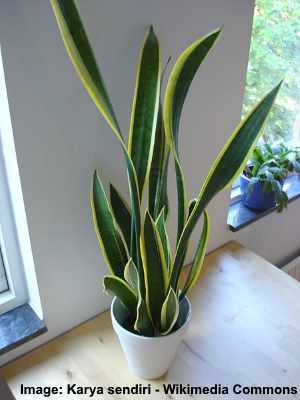
The ‘Black Gold’ is a common variety of snake plant (‘viper’s bowstring hemp) with green and yellow tall leaves
The ‘Black Gold’ sansevieria (viper’s bowstring hemp) is a popular type of perennial snake plant cultivar that has dark green leaves and a striking golden-yellow edge. This viper’s bowstring hemp plant has stiff fibrous leaves of grow tall, giving the plant a distinct sleek look.
Most sansevieria trifasciata varieties grow to about 35” (90 cm) tall and the green and yellow leaves can be up to 2.5” (6 cm) wide. You may notice that small tubular flowers appear in the summer or fall.
This snake plant variety is one of the 10 best air filtering house plants according to NASA. Many people choose to grow this sansevieria variety in their bedroom or living room for cleaning out the air both day and night. But you need to be aware that all parts of the viper’s bowstring hemp plant are poisonous or toxic to cats and dogs. According to the Chinese Feng Shui, the snake plant is one of the lucky plants that help bring good fortune.
As with most sansevieria varieties, this snake plant can tolerate low-light conditions with occasional watering.
Sansevieria Trifasciata ‘Futura Robusta’
This type of ‘mother-in-law’s tongue’ is an evergreen sansevieria that has grayish-green leaves in striped patterns. The shorter sword-shaped leaves grow in a dense clump and are identified by their twisted growth. Unlike most other sansevieria trifasciata varieties, the ‘Future Robusta’ only reaches heights of around 24” (60 cm).
This sansevieria houseplant grows well in most indoor conditions and can withstand infrequent watering.
Sansevieria Trifasciata ‘Twisted Sister’
The snake plant ‘Twisted Sister’ gets its name from the way the green and yellow leaves curl around to give them a distorted shape. The striking look of this sansevieria plant comes from its bright golden yellow and lime green variegated leaves. You will also notice silvery-green markings in the center of the leaves.
Many describe the look of the ‘Twisted Sister’ as a bird’s nest in a container.
This is also a dwarf variety of sansevieria trifasciata as the leaves only grow to between 12” and 15” (30 – 38 cm) tall. Because of its bright green and yellow colors, this snake plant can brighten up a dull corner of any room.
Sansevieria Trifasciata ‘Golden Hahnii’
Another dwarf variety of sansevieria is the ‘Golden Hahnii,’ sometimes also called the Bird’s Nest’ sansevieria. The wide tapered leaves of this snake plant variety have green and light green striped markings running horizontally. As the leaves grow, they form clusters and become leafy funnels. Looking at the ‘Golden Hahnii’ from above, you will notice a rosette pattern to its shape.
This short variety of sansevieria will only grow to about 12” (30 cm) high. To create a striking effect, grow the plant in clumps rather than as a single snake plant.
Sansevieria Trifasciata ‘Futura Superba’
The sansevieria trifasciata ‘Futura Superba’ certainly lives up to its name of superb. This variegated cultivar looks like a smaller version of the ‘Black Gold’ snake plant with bright green leaves and golden yellow edging. One of the differences between this trifasciata species and the ‘Black Gold’ one is that its leaves are shorter and wider. The brightly colored green variegated leaves of this mother in law’s tongue grow straight and tall.
The ‘Futura Superba’ snake plant is perfect as a houseplant where there in poor light conditions and not a lot of space.
Sansevieria Trifasciata ‘Laurentii’
One of the tallest varieties of sansevieria trifasciata is the ‘Laurentii’ cultivar. This snake plant has tall elegant variegated yellow and green leaves. The grayish-green leaves have stripy patterns along their length. The yellow band running the length of the ‘snake’ leaves gives style and elegance to this sansevieria variety.
Expect this striped snake plant to grow to between 2 and 4 ft. (60 – 120 cm) tall. This robust type of leafy plant grows well in most conditions. Due to its tall-growing nature, it is a good type of tropical houseplant to place in corners where some height is needed.
Sansevieria Ehrenbergii (Blue Sansevieria)
The ‘Blue Sansevieria’ snake plant has thick succulent leaves that grow in a fan shape. Its name of ‘Blue’ snake plant doesn’t really describe its color. The leaves are shaped like a canoe or boat with a rounded underside and grooved channel on the topside.
The fleshy leaves grow in dense clusters and have a blue tinge to them when immature. As the sansevieria grows, the leaves become a dark green to gray-green color and may have a light red line along their wavy edges.
One of the striking features of this sansevieria is its size. Long succulent leaves about 5 ft. (1.5 m) in length and 3” (8 cm) wide grow on a short stem. However, this snake plant takes a long time to reach maturity and is a delightful small sansevieria for many years.
Other names for this variety of sansevieria include ‘Sword Sansevieria,’ ‘Somaliland Bowstring Hemp,’ and ‘East African Wild Sisal.’
Sansevieria Ehrenbergii ‘Banana’
The sansevieria ‘Banana’ is a type of succulent that gets its name from its banana-shaped fleshy leaves. Belonging to the sansevieria species Ehrenbergii, this plant has similarly shaped leaves to the ‘Blue Sansevieria.’ One of the differences is that the thick leaves are shorter as it’s a dwarf variety.
The leaf shape is also described as ‘boat-shaped.’ They have a rounded bottom and an inwardly curved topside. In some ways, the color of this sansevieria resembles that of succulents such as agave plants. The leaves are a light bluish-green color with faint striped marking running their length.
One of the identifying features of the ‘Banana’ sansevieria is a straight leaf growing in the center. Thick leaves arch out alternately from either side of the center leaf.
For a more unusual type of sansevieria Ehrenbergii, look for the variegated cultivar. This has a grayish-green upper side with a bright yellow, banana-colored underside.
Sansevieria Kirkii (Star Sansevieria)
The ‘Star Sansevieria’ is one of the more unusual varieties of snake plants due to its wide tapered leaves and light markings. The ‘Star’ leaves grow up to 6 ft. (1.8 m) long and can measure 3.6” (9 cm) at their widest. Cream-colored markings on the leaf surface also help to identify this sansevieria species.
As a houseplant, the sansevieria kirkii ‘Star’ grows dark-green snake-like leaves up to 3 ft. (1 m) tall. The leaves of this houseplant variety seem to be narrower than the outdoor variety. When growing in clumps, the Star Sansevieria can have an eye-catching appearance with its spiky look and tall leaves.
Another unusual feature of this plant is the large conical white or pale pink flowers that can sometimes emerge. These give off a fresh scent; however, it only blooms rarely.
Sansevieria Patens
The ‘sansevieria patens’ is one of the most attractive snake plant succulents that you can find. This type of sansevieria plant is identified by its cylindrical fleshy leaves that grow in a rosette form. The leaves can reach up to 3 ft. (90 cm) long. As the leaves mature, they start to arch in different directions. This makes the plant look like a collection of writhing snakes. As the snake plant matures, it turns from a dark green color to a bluish-green shade.
Another way to identify the sansevieria patens is by the deep grooves running along the length of the leaves.
To get the best color on the leaves, place the sansevieria in a well-lit place away from direct sunlight. However, as with most snake plants, the sansevieria patens can tolerate some neglect.
Sansevieria ‘Cleopatra’
One of the most attractive varieties of sansevieria is the ‘Cleopatra’ cultivar with its delightful patterns on succulent leaves. The leaves have a crisscross of dark green lines on a light green background. Its beauty is enhanced by the rippled edges that are highlighted by a reddish-brown line.
Another of the attractive features of this sansevieria species is its perfect rosette pattern. Because this snake plant succulent only grows to about 11” (27 cm) tall, you can place it almost anywhere in a room, office, or patio.
Sansevieria Parva (Kenya Hyacinth)
This delightful sansevieria Parva variety, also called the ‘Kenya Hyacinth,’ has light-green narrow leaves with darker patterns. These snake-like leaves grow in a rosette pattern and give the succulent a spiky look. Each of the leaves grows to about 16” (40 cm) long and there are between 6 and 12 in each clump.
All sansevieria varieties are flowering plants, and the ‘Kenya Hyacinth’ is no exception. When it does flower, you can expect to see pretty pinkish-white flowers.
Sansevieria Zeylanica (Ceylon Bowstring Hemp)
Also called the ‘Devil’s Tongue’ or ‘Mother-in-Law’s Tongue,’ this variety of sansevieria has upward-growing leaves in a sword shape. The thick leaves of the ‘Ceylon Bowstring Hemp’ have dark and lighter green markings. In some places, you may see white patches that are completely normal. You can expect the leaves to grow up to 2.5 ft. (75 cm)
This green tropical plant looks best when the snake leaves grow in clumps together. The long sharp upright erect leaves can make an attractive feature in any room. They can also be grown in a row to create a natural room divider or modern office feature.
Sansevieria Masoniana F. Variegata
Also called ‘Mason’s Congo,’ this variety of sansevieria has some of the widest and attractive leaves you will find on any snake plant. This type of sansevieria is recognized by its long leaves with an almost oval shape. The large leaves grow to 4 ft. (1.2 m) long and are about 10” (25 cm) at their widest point.
The beautiful variegation is one of the attractions of this semi-succulent plant. Bright golden yellow and pale-yellow stripes contrast well with the dark green leaf coloring. The large blade-shaped foliage will make for an eye-catching feature in any room.
Sansevieria Ballyi (Dwarf Sansevieria)
If you are looking for a small variety of sansevieria, then the dwarf ‘Ballyi’ is a good choice. The sansevieria Ballyi has beautiful variegated narrow tapered leaves that grow 4” (10 cm) long and only measure 6” (15 cm) tall. These succulent leaves grow in a rosette pattern and their light-yellow and pale green bands create an attractive display.
Every so often, you will get some white/pink blossoms from this dwarf sansevieria.
Sansevieria Trifasciata ‘Cylindrica’
The sansevieria trifasciata ‘Cylindrica’ is a snake plant with very long tubular leaves. As with most varieties of sansevieria, its leaves have markings in various shades of green. You can expect the fleshy cylindrical sansevieria leaves to grow up to 7 ft. (2 m) long and be around 1” (2.5 cm) thick at the base.
The shape of the sansevieria cylindrica plant is rosette; however, the long succulent leaves grow in a fan shape.
Sansevieria cylindrica is also called African Spear or Spear Sansevieria, Elephant’s Toothpick, Cylindrical Snake Plant, or in Brazil Saint Bárbara sword. Sansevieria Cylindrica also has the botanical name Dracaena angolensis.
One of the most attractive ways to grow sansevieria ‘Cylindrica’ is as container plants. The attractive cylinder leaves can be braided or left to grow in a natural fan shape.
Sansevieria Cylindrica ‘Boncel’ (Starfish Sansevieria)
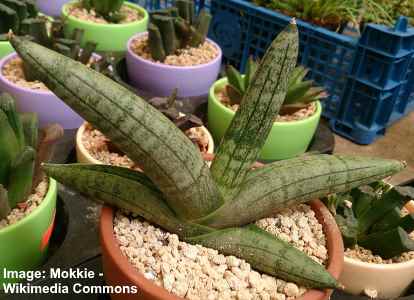
The Sansevieria Cylindrica ‘Boncel’ (Cylindrical Snake Plant) has cylindrical gray-green fleshy leaves
Sansevieria cylindrica ‘Boncel’ is a type of sansevieria with tubular leaves in the shape of a spike. Also called cylindrical snake plant, or starfish sansevieria, this snake plant cultivar is identified by its grayish-green color and bands of darker green marks around the leaves. Depending on the container size, the cylindrical fleshy green leaves can grow up to 7 ft. (2 m) long.
Sansevieria cylindrica ‘patula’ is another variety that looks very similar to the boncel verity.
One of the most stunning features of sansevieria cylindrica ‘Boncel’ is the long flower stem that grows. When the starfish sansevieria plant flowers, its flowering stem grows 3 ft. (1 m) tall and its length is covered in small greenish-white tubular flowers.
Sansevieria Eilensis
The Eilensis snake plant is a dwarf variety of succulent in the genus Sansevieria and is a slow-growing plant with bluish-green leaves. Identification of this sansevieria species is by the thick leaves that curve downwards as they grow. The plump leaves eventually grow up to 5” (12.5 cm) long and measure about 1” (2.5) thick.
Another way to identify the sansevieria Eiensis is by the longitudinal lines running the length of the leaves. These are where the leaves expand and shrink, depending on the amount of water it receives. You will also notice a type of cuticle on the tips of each banana-shaped leaf.
Even though there are typically only 2 or 3 leaves, this dwarf sansevieria variety is an attractive addition to any room.
Sansevieria Moonshine

The moonshine snake plant is an eye-catching sansevieria plant with pale, silvery-green, spear-shaped leaves. The moonshine snake plant has broad, pointed succulent leaves that have an attractive dark green margin.
Common names for Sansevieria Moonshine include sansevieria silver queen, sansevieria moonglow, and moonlight snake plant.
The moonshine snake plant is an easy-care houseplant which is ideal for beginners or plant experts alike. You can grow the stunning moonshine plant in most conditions and it survives in low-light with little water. In addition, its short upright sword-like leaves don’t take up much room.
Snake Plant Care
One of the great reasons to have a few sansevieria plants at home is that they are very easy to care for. In fact, some people say that these succulents are the kind of plants that seem to thrive on neglect.
What are the most important factors to remember when caring for a snake plant?
Climate
These tropical plants grow well indoors at normal room temperature. However, it’s important to keep your sansevieria plants away from drafts.
Light
Keep your snake plant in a well-lit room and away from direct sunlight. Even though all varieties of sansevieria tolerate dark conditions, bright light helps to bring out the beautiful colors on the leaves.
Water
As with any succulent, all types of sansevieria need well-drained soil to grow healthily. Only water your succulent plant when the soil is dry and allow all the water to drain out the bottom of the container. In winter, you only need to water your sansevieria plants occasionally.
Related: Mother-in-Law’s Tongue (Snake Plant): Care and Growing Guide
Related articles:

